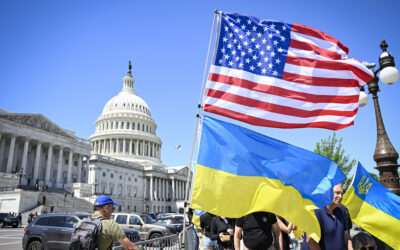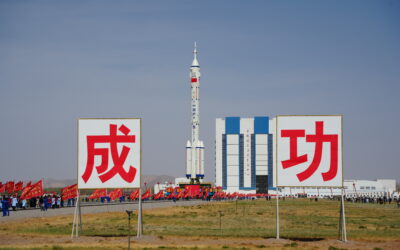OPINION — After his speech at the Georgia Institute of Technology last Thursday, CIA Director William Burns was asked about the risks that President Biden is facing in helping Ukraine fight the Russian invaders against a background of Russian President Vladimir Putin’s threats implying the possible use of nuclear weapons.
Burns responded, “I know President Biden is deeply concerned about avoiding a third world war, [and] avoiding a threshold in which you know, nuclear conflict becomes possible.”
That’s the world we must face today as Russia builds up its damaged forces to begin a new, major, military offensive in Ukraine’s eastern Donbas region.
Last Tuesday, President Putin told a television audience, “Regrettably, neo-Nazism has become a fact of life in a big country [Ukraine] with which we had close affinity. What we are doing there is helping people, saving them from genocide, on the one hand, and at the same time, we are taking measures to ensure the security of Russia itself – it is obvious that we had no alternative and that it was the right step.”
Putin added, “And there is no doubt that we will definitely attain the goals set.”
Despite initial Russian losses, Putin has not given up on bringing Ukraine back into his orbit. In Putin’s world, a Nazi is a Ukrainian who refuses to admit being a Russian and therefore, Ukraine as a separate country, has to be eliminated.
The U.S., NATO and the European Union countries have responded to a new Russian build up by providing the Ukraine military with more sophisticated military equipment, some of which could be used for offensive operations.
The fact that President Biden’s latest $800 million worth of arms to Ukraine includes helicopters, 155-millimeter artillery, sophisticated radars, and armored personnel carriers caused Moscow last Tuesday, to deliver to Washington a threatening diplomatic note titled, “On Russia’s concerns in the context of massive supplies of weapons and military equipment to the Kiev regime.”
The note began, “We call on the United States and its allies to stop the irresponsible militarization of Ukraine, which implies unpredictable consequences for regional and international security,” according to The Washington Post’s Karen DeYoung.
Despite military setbacks and last week’s embarrassing loss of its Black Sea flagship, the missile cruiser Moskva, Putin remains determined to destroy Ukraine in a brutal fashion, starting this time in an area where Russia has advantages.
The Cipher Brief hosts expert-level briefings on national security issues for Subscriber+Members that help provide context around today’s national security issues and what they mean for business. Upgrade your status to Subscriber+ today.
Last Thursday, two Pentagon briefers described Russian preparations for what one called, “a heavier offensive in the Donbas region.” That involved, “putting in place artillery units, moving them in, moving in command-and-control enablers, moving in aviation support…we saw some more helicopters being staged to the north of the Donbas in Russia just in the last 24 hours. They’re doing the things that — that — that we believe they believe they need to do to set the proper conditions for a — a renewed ground offensive. But we have not seen a great influx of additional battalion tactical groups into the region yet.”
Russian units, part of the forces withdrawn from the northern part of Ukraine, are now in Belarus and/or Russia, refitting and resupplying, according to the Pentagon briefings. They could potentially reinforce troops already fighting in the Donbas region. “We’ve already seen that they’re pushing some of those forces back into Ukraine, just to the north of the Donbas,” one briefer said, “and we would expect that reinforcement to continue.”
Moscow has made another change, naming Gen. Aleksandr Dvornikov as the single military leader for all Russian forces in Ukraine. He ran the Russian air war in Syria and, according to Pentagon press secretary John Kirby, has a history of “utter disregard” for avoiding harm to civilians, as well as the laws of war. More recently, Dvornikov has commanded Russia’s own southern military district and since the February invasion, Moscow’s forces in the southern Ukraine.
The Pentagon briefers described his appointment as, “an effort to simply improve their command and control,” which has been a problem for the Russians up to now.
Unlike Russia’s earlier unsuccessful attempt to reach Kyiv from the north, starting a new offensive from the Donbas offers shorter supply route lines for Putin’s forces because that region is along the Russian border. Another advantage is that many of the Russian forces are familiar with the territory since they’ve been fighting there for eight years.
One Pentagon briefer pointed out that the topography had, “been described to me, that part of Ukraine is a bit like Kansas, so it’s a little bit flatter, it’s a little bit more open. And it’s the kind of place where we can anticipate that the Russians will want to use tanks and long-range fires, artillery, and rocket fire to achieve some of their objectives before committing ground troops.”
He also said, “The weather will certainly be a factor in war, as it always is, and the fact that the ground is softer will make it harder for them [the Russians] to do anything off of — off of paved highways. But — but again, we’ll just have to, you know, we’ll — we’ll have to see how this plays out.”
The Pentagon briefers discussed the U.S. military equipment in the latest $800 million package put together, they said, “in recognition of what the Russians are preparing to do.”
On the list, are 18, 155-millimeter howitzers and 40,000 artillery rounds. These artillery pieces can reach from 11 to 20 miles and are, “reflective of the kind of fighting that the Ukrainians are expecting to be faced with here in this little bit more confined geographic area,” Pentagon spokesman Kirby said last week, adding, “and if they need additional artillery rounds, clearly the United States will do what we can to fill those needs.”
Also on the list, are 10 TPQ-36 counter-artillery radars; which not only can locate enemy mortars, artillery, and rockets as they are fired, but also help adjust friendly fire against those weapons. Another radar in the package are two so-called Sentinel air surveillance radars, which provide not only persistent air surveillance, but also fire control data to the warfighter to defeat unmanned aerial systems, cruise missiles and fixed and rotary-wing aircraft threats up to 45 miles away.
Other items include: 200 M113 Armored Personnel Carriers that can carry two crew and 11 passengers; 100 Armored High Mobility Multipurpose Wheeled Vehicles, the so-called Humvee which supports combat and combat service support units; 300 Switchblade, miniature back-packable tactical drones that are ground-directed to targets and detonate when they crash into their targets, and 500 Javelin missiles and thousands of other anti-armor systems.
Kirby told Pentagon reporters last week, “We believe that we can put together appropriate training for some of these systems very, very quickly… It will probably require some additional training for…. the howitzers, the TPQ-36 counter artillery radar — not a very difficult system to operate…[and] the Sentinel air surveillance this is an air defense radar system, a 3-D phased array. And that also is going to require a little bit of training on for that.”
He added it would probably be a, “train-the-trainer’s program,” where they would, “pull a small number of Ukrainian forces out [of Ukraine] so that they can get trained on these systems,” not in the U.S., but in a European country “and then send them back in.”
Retired-U.S. Army Lt. Gen. Mark Hertling, once Commanding General, U.S. Army Europe, described in Tweets last Thursday, what he would do if he were in command of the Ukraine Army force. The first thing would be to ensure the force was flexible and mobile. Hertling wrote, “To be flexible and mobile in the Donbas, there’s a need for up-armored wheeled vehicles rather than tracked vehicles (Hummers with Javelins and Stingers inside), [and] helicopters.”
Mobile units would have a lot of soldiers who knew how to use Javelins, Stingers, Switchblades, etc. and they would be supported by artillery in a centralized location with counter-fire radar. Hertling’s second thing would be to find “ways to establish Quick Reaction Forces (QRF’s) to counter any [Russian] breakthrough.” He wrote, “QRF mobile units would have a lot of soldiers who knew how to use Javelins, Stingers, Switchblades, etc and they would be supported by artillery in a centralized location with counter-fire radar.
With a sharp increase in missile attacks on Ukraine cities over the weekend and on Monday, it is clear the major Russian Donbas offensive will soon begin. A key question is what the U.S. and its NATO allies will do if Russian troops overwhelm the Ukraine forces in the Donbas region and attempt to continue on toward Kyiv, killing civilians and laying waste to cities, towns and villages in their wake?
Would public reaction to pictures and videos of Russian-perpetrated death and destruction force Biden or any NATO leaders to get more directly involved militarily?
CIA Director Burns said last week, “The [Russian] crimes in Bucha are horrific. The scenes of devastation in Mariupol and Kharkiv are sadly reminiscent of the images I saw in Grozny, in Chechnya, as a young diplomat in the winter of 1994-95: Forty square blocks in the center of the city flattened by Russian shelling and bombing, leaving thousands of civilian deaths.”
Burns also said, “The last chapter in Putin’s war has yet to be written as he grinds away at Ukraine.”
Read more expert-driven national security insights, perspective and analysis in The Cipher Brief because National Security is Everyone’s Business










